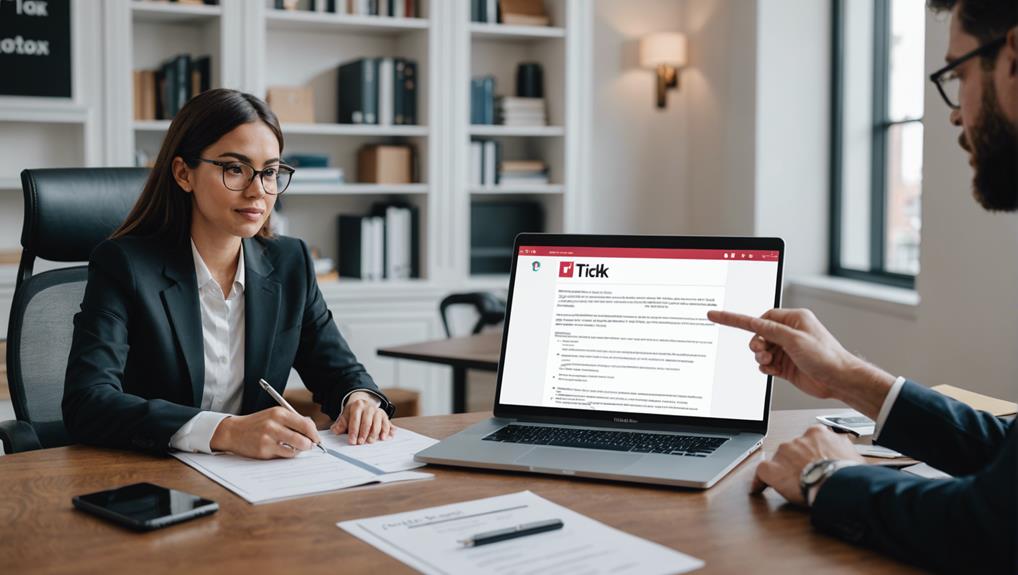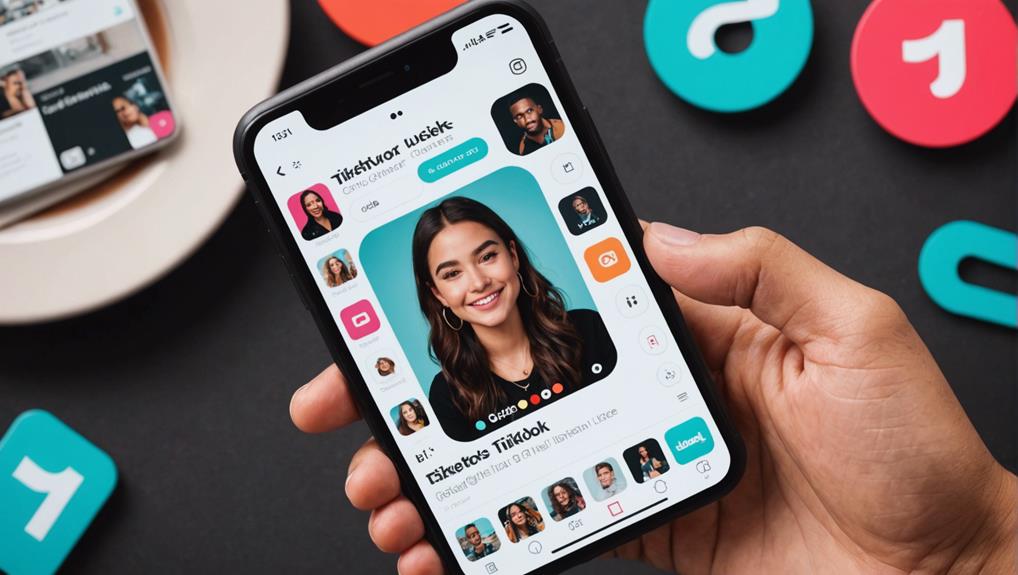To track TikTok influencer ROI effectively, start by defining campaign objectives using SMART criteria, ensuring alignment with broader marketing goals. Identify key metrics, including engagement rates and conversion rates, which provide insights into audience interaction and campaign impact. Regular engagement rate analysis allows for strategic adjustments. Assess conversion rate impacts through authentic influencer collaborations that align with brand messaging. Track hashtag performance to refine strategies and boost campaign visibility. Choose relevant influencers who resonate with your target audience. Ultimately, focus on fostering long-term relationships with influencers to leverage consistent brand messaging and enhanced campaign effectiveness. Insights await.
Key Takeaways
- Focus on engagement rates to assess influencer campaign effectiveness on TikTok.
- Track conversion rates to measure audience interest and campaign success.
- Monitor hashtag performance to gauge campaign visibility and engagement.
- Analyze audience interaction to optimize influencer partnership strategies.
- Benchmark against industry standards to enhance content performance and ROI.
Define Campaign Objectives
Establishing clear campaign objectives is a foundational step towards achieving impactful influencer marketing strategiesg> on TikTok. By utilizing the SMART criteria—Specific, Measurable, Achievable, Relevant, and Time-bound—brands can guarantee that their influencer partnerships align closely with overarching marketing goals. This strategic alignment is vital for driving measurable outcomes, such as increasing brand awareness or enhancing tracking accuracy. For instance, targeting a 20% increase in brand awareness or a 15% boost in website traffic within a defined timeframe exemplifies how specific objectives serve as benchmarks for success.
Furthermore, campaign objectives should be dynamic, allowing for adaptability to TikTok’s evolving trends while maintaining a focus on measurable outcomes. This flexibility facilitates timely adjustments based on audience engagement and performance data, optimizing influencer partnerships for enhanced return on investment (ROI).
Clarity in these objectives not only informs influencer selection but also guides content creation, guaranteeing that collaborations effectively resonate with the target audience. Regularly revisiting and refining objectives based on performance data enables brands to fine-tune their strategies, guaranteeing long-term success and improved ROI in their TikTok influencer campaigns.
As a result, well-defined campaign objectives are instrumental in maximizing the efficiency and impact of influencer marketing efforts.
Identify Key Metrics
Identifying key metrics is essential for any brand aiming to accurately measure TikTok influencer ROI. By focusing on the right tracking metrics, businesses can gain precise insights into campaign performance. Engagement rate is a pivotal metric, calculated using the formula (Total Engagement / Total Reach) * 100, which provides a clear picture of audience interaction with influencer content. Conversion rates are equally important, reflecting how effectively these campaigns drive desired actions like sales or sign-ups, directly influencing overall influencer ROI.
Hashtag performance offers another layer of insight by measuring reach and engagement, helping brands assess content resonance and virality. Impressions and clicks further underscore the significance of understanding user interaction and content visibility, with 90% of influencer programs emphasizing engagement tracking.
| Metric | Purpose |
|---|---|
| Engagement Rate | Measures audience interaction |
| Conversion Rates | Assesses effectiveness in driving actions such as sales or sign-ups |
| Hashtag Performance | Evaluates reach and content resonance |
Regular analysis of these key metrics, including follower growth and content performance, is essential. This allows for the refinement of future influencer collaborations and the optimization of overall campaign strategies, ensuring a robust approach to enhancing influencer ROI.
Engagement Rate Analysis
Engagement rate serves as a critical metric for evaluating the effectiveness of TikTok influencer campaigns, calculated by comparing total engagements to total reach.
By benchmarking these rates against industry standards, brands can effectively gauge their performance relative to competitors, offering valuable insights into audience interaction levels.
Regular analysis of these metrics not only highlights trends but also guides strategic adjustments to enhance audience engagement and bolster campaign outcomes.
Calculating Engagement Rate
To effectively measure the impact of TikTok content, calculating the engagement rate is essential for brands and influencers aiming to optimize their digital strategies. The engagement rate, determined by the formula: (Total Engagement / Total Reach) * 100, provides valuable insights into how content resonates with audiences.
For instance, a TikTok post accumulating 10,000 likes, 500 comments, and 200 shares would result in an engagement rate of 10.7%, indicating a strong audience interaction. This metric is vital for evaluating the performance of influencer marketing campaigns and ensuring that the content effectively engages the target demographic.
Analytics tools play a pivotal role in simplifying the calculation and tracking of engagement rates, allowing marketers to gauge ROI efficiently. By consistently analyzing these metrics, brands can discern patterns and adapt their strategies to enhance audience connection.
High engagement rates signify content that resonates well, fostering a robust relationship between the influencer and their followers. This alignment is critical for maximizing the effectiveness of TikTok campaigns.
Although establishing benchmarks through industry standards is important, the primary focus should be on leveraging engagement data to drive continuous improvement and achieve superior marketing outcomes.
Benchmarking Industry Standards
In the ever-evolving landscape of social media marketing, understanding industry benchmarks for engagement rates on TikTok is vital for brands aiming to optimize influencer partnerships. TikTok Influencer Marketing thrives on high engagement rates, which typically range from 5% to 10%, surpassing those on other platforms. This metric is fundamental for evaluating campaign performance and influencers’ content efficacy.
For instance, an influencer with 100,000 followers receiving 10,000 likes, 500 comments, and 200 shares achieves a 10.7% engagement rate, indicating strong audience interaction.
Industry benchmarks highlight the correlation between higher engagement rates and superior content performance, underscoring the importance for brands to comprehend their specific benchmarks for accurate assessment. Such understanding aids in obtaining positive ROI from influencer collaborations. However, engagement rates can vary across different niche markets, influencing the overall effectiveness of influencer partnerships. Consequently, brands must tailor their analysis to their specific category to enhance brand performance.
Consistent tracking engagement over time is pivotal, as it reveals trends and audience preferences, thereby refining content strategies for maximum impact. This data-driven approach guarantees that brands remain competitive and adaptive in the dynamic TikTok ecosystem, ultimately fostering enhanced campaign outcomes.
Analyzing Audience Interaction
A robust understanding of audience interaction on TikTok is vital for brands seeking to maximize the effectiveness of influencer partnerships. The engagement rate, a key metric calculated as (Total Engagement / Total Reach) * 100, provides insight into how well an influencer’s content resonates with audiences.
For instance, an engagement rate of 10.7%, as seen in scenarios with 10,000 likes, 500 comments, and 200 shares, signifies that the content is driving meaningful interactions. This data-driven approach allows brands to assess and enhance content performance and campaign effectiveness.
Regularly analyzing engagement rates is essential for several reasons:
- Trend Identification: By monitoring engagement rates over time, marketers can identify patterns that inform strategic adjustments to enhance audience interaction and content performance.
- Benchmarking Against Competitors: Establishing industry benchmarks enables brands to measure an influencer’s effectiveness against competitors and market standards, ensuring peak campaign performance.
- Improved Campaign Tailoring: Leveraging engagement rate data helps brands design future campaigns that align more closely with audience preferences, ultimately driving higher conversion rates.
Conversion Rate Impact
In evaluating the conversion rate impact of TikTok influencer campaigns, aligning with the target audience and crafting content strategies that emphasize relevance are critical factors.
Data indicates that when an influencer’s message resonates with the audience’s interests, conversion rates can reach impressive levels, such as 6.02%.
Strategically leveraging insights on demographics and interests not only boosts immediate conversion outcomes but also informs future content approaches to enhance audience engagement and response.
Target Audience Alignment
Target audience alignment is a strategic imperative in influencer marketing, fundamentally affecting conversion rate outcomes. When campaigns resonate with the right demographics, conversion rates can increase by 4-6 times, underscoring the power of targeted influencer collaborations on platforms like TikTok.
Given TikTok’s diverse user base, particularly the significant engagement from users over 25, selecting influencers who appeal to this demographic is crucial for brands targeting older audiences. Brands that partner with TikTok influencers who authentically represent their products experience a 10-20% uptick in conversion rates, highlighting the importance of genuine audience connection and tailored influencer content.
- Authentic Representation: Collaborating with influencers who naturally align with brand messaging can yield a 10-20% increase in conversion rates, enhancing overall campaign performance.
- Demographic Targeting: Effective targeting through influencer partnerships can boost conversion rates by 30%, as well-aligned content fosters trust and relatability.
- Content Alignment: Influencer content that aligns with brand messaging can lead to a 50% increase in engagement rates, directly impacting conversion outcomes positively.
Through strategic target audience alignment, brands not only enhance engagement rates but also drive meaningful conversion improvements, making it an essential component in tracking TikTok influencer ROI.
Content Relevance Strategy
When influencers create content that is closely aligned with a brand’s core message, conversion rates can experience a substantial boost, underscoring the significant impact of content relevance. Data reveals that influencer campaigns focusing on content relevance can enhance conversion rates by up to 60%. This improvement is attributed to the ability of engaging content to resonate with target audiences on TikTok, effectively transforming viewer interest into consumer action.
Given that 75% of consumers are more inclined to purchase following a relatable influencer endorsement, the strategic alignment of influencer messaging with brand values and audience demographics is essential.
Analyzing performance on TikTok, brands have reported up to 30% higher ROI when influencer partnerships prioritize content relevance. This highlights the necessity for meticulous campaign management, guaranteeing that every piece of content not only engages but also aligns with the expectations and needs of the target audience.
Continuous evaluation of content performance and audience feedback is vital, allowing for strategy refinement. By doing so, brands can guarantee that their influencer campaigns consistently yield effective ROI, leveraging the power of content relevance to drive both engagement and sales conversions.
Hashtag Performance Tracking
Understanding hashtag performance on TikTok is essential for brands aiming to maximize their influencer marketing ROI. By analyzing metrics such as views, likes, shares, and comments, brands can effectively gauge the engagement and reach of influencer content associated with specific hashtags.
Branded hashtags play a vital role in tracking performance, as they can highlight trends and measure campaign effectiveness, especially when viral challenges boost brand visibility and user interaction. These insights provide a clearer picture of conversion rates attributable to influencer efforts, ultimately enhancing ROI through strategic insights.
To optimize hashtag performance tracking, brands should focus on the following:
- Performance Benchmarks: Establishing benchmarks for hashtag performance helps brands refine their content strategy by identifying which hashtags drive the most engagement and resonate with the target audience.
- Trend Analysis: Regularly monitoring the performance of branded hashtags allows brands to identify trends, ensuring that campaigns remain relevant and effective in a dynamic TikTok landscape.
- Conversion Tracking: By monitoring unique hashtags, brands can directly attribute conversions to specific influencer campaigns, offering a more precise understanding of ROI.
Choose Relevant Influencers
Selecting the right influencers is a critical component in enhancing a brand’s campaign effectiveness on TikTok, as it demands careful analysis of audience demographics and engagement metrics to guarantee alignment with the brand’s target market.
When selecting influencers, it is essential to evaluate their audience profiles to verify that their followers match the brand’s target demographics. High engagement rates are indicative of an influencer’s ability to captivate their audience, which can lead to more effective outreach and connection for the brand.
Focusing on influencers whose content naturally complements the brand’s messaging can greatly improve campaign outcomes. Authentic partnerships can enhance audience trust and drive more meaningful interactions, resulting in better campaign results.
Additionally, examining an influencer’s past performance in similar campaigns can provide valuable insights into their potential impact on a brand’s objectives.
Collaborating with influencers who share similar values with the brand can foster a genuine connection, further enhancing the campaign’s overall impact. By aligning with influencers whose audience resonates with the brand’s niche, companies can increase visibility and achieve more substantial engagement.
This strategic selection process guarantees that the influencer’s audience becomes a valuable extension of the brand’s market reach.
Foster Long-term Relationships
Developing long-term relationships with TikTok influencers is pivotal in enhancing brand authenticity and audience trust. By continuously collaborating with influencers, brands can guarantee a more authentic representation of their values and messaging. Influencers, in turn, gain an extensive understanding of the brand, resulting in creative content that resonates with audiences.
This authenticity fosters positive brand perception and higher engagement rates, as evidenced by studies showing a 67% increase in engagement for campaigns leveraging long-term influencer partnerships.
A strategic approach to influencer marketing efforts involves the following advantages:
- Cost Efficiency: Long-term collaborations allow for negotiation of reduced rates, thereby decreasing campaign costs and enhancing the ROI. By lowering per-campaign expenses, brands can allocate resources more effectively across their marketing efforts.
- Consistent Brand Messaging: Ongoing partnerships enable influencers to tell a cohesive brand story over time, maintaining audience interest and engagement. This sustained narrative aligns with evolving trends, keeping the brand relevant.
- Access to Evolving Creativity: Continuous partnerships allow brands to leverage influencers’ evolving insights and creativity. This collaboration yields innovative content that taps into current trends, effectively engaging the target audience.
Thus, fostering long-term relationships with influencers is a strategic approach to maximizing ROI.
Frequently Asked Questions
How to Track Influencer ROI?
To effectively track influencer ROI, define campaign goals and evaluate influencer metrics, focusing on engagement analytics, conversion rates, and content performance. Analyze audience demographics, brand awareness, and sales attribution to guarantee strategic alignment and measure marketing success.
How to Track Influencer Traffic?
To track influencer traffic effectively, utilize tracking software and referral links to analyze engagement metrics and click-through rates. Leverage influencer analytics for audience insights and evaluate content performance to determine campaign effectiveness and accurately measure traffic sources.
What Is ROI in Tiktok?
ROI in TikTok is the measurement of a campaign’s success, evaluated through TikTok metrics like engagement rates, content quality, audience demographics, and brand alignment. Effective influencer selection and platform growth are essential for aligning with campaign goals.
What Is the Average ROI for Influencers?
The average ROI for influencer marketing hovers around $5.78 per dollar spent. Effective campaign strategies, high engagement rates, precise audience demographics, strong brand awareness, superior content quality, and partnership longevity are critical factors influencing conversion metrics and ROI outcomes.
Conclusion
To summarize, the effective tracking of TikTok influencer ROI necessitates a structured approach centered on clear campaign objectives and the identification of key metrics. Analytical evaluation of engagement rates and conversion impacts, coupled with hashtag performance tracking, provides quantitative insights essential for evaluating campaign success. Selecting relevant influencers and fostering long-term relationships further enhances the potential for favorable outcomes. This data-driven framework supports the strategic optimization of influencer marketing efforts on TikTok, ensuring measurable and impactful results.




